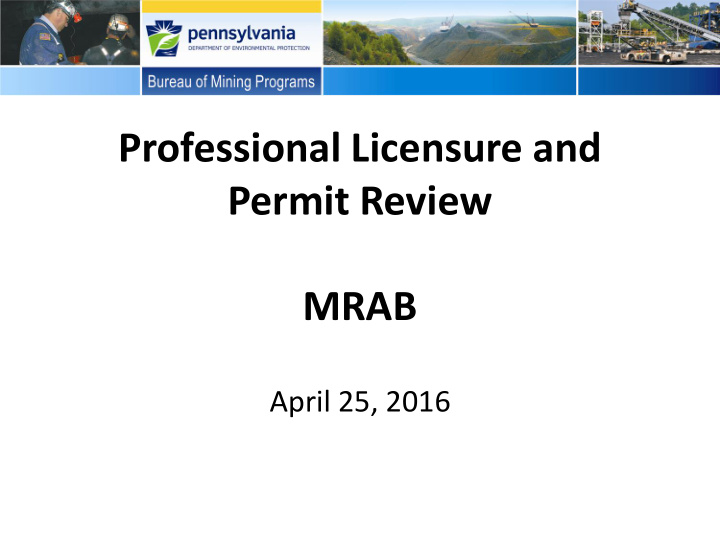



Professional Licensure and Permit Review MRAB April 25, 2016
Professional Licensure and Permit Review Purpose: Discuss the roles of the applicant’s consultant and Department with regards to PE- and PG- licensed work in the context of shortening permit review times.
Department responsibilities Department must conduct certain tasks under the regs: • Collects, evaluates public comments, holds hearing • Makes written findings • “waives”, “determines” • “evaluates impacts”
Department responsibilities DEP is responsible for permitting decisions Written findings (86.37) • Criteria for permit approval/denial • Legal obligation that ensures the project is in compliance with laws and regulations • No presumptive evidence of pollution
Consultant responsibility Present complete and understandable set of information for Department to make decision • Gather and compile data and plans • Address consequences of proposed activities (water loss replacement, contingency plans, anticipated problems, etc.)
Sealed Submittals Difference between practice of engineering and geology: • PE – Standards in design; done according to accepted specifications, best practices • PG – Data collection, interpretation, prediction Preparation by licensed individuals is required by law.
Sealed Submittals Example – Groundwater hydrology • Critical piece of permit review, CHIA (federal requirement) is cumulative in a watershed • Complicated, open for interpretation • Risk of pollution, water loss, hydrologic balance impacts • Financial interests at stake • Grounds for appeal
Permit review is complex Applicant/consultant is making a claim regarding prediction of pollution. – Interpretation is involved – Review for errors, professional judgment needed DEP uses additional information it deems relevant • Including assessing info that disputes the claim/prediction • Comments and input by others must all be fairly considered (citizens, municipalities, other agencies, other consultants)
Permit review is complex More is considered by DEP than information presented/sealed • Some data and resources are contained only within the Department • May be confidential • Historic and current complaint investigations • Institutional and historical knowledge from other staff • Comprehensive
Conflicts of Interest • Ethics act and disclosure of interests • Bias (conflicts may or may not be apparent) • Employment by mining companies • Defending the work, if permit is appealed Conclusion: It is not feasible to conclude the parts of applications can receive auto-approval based on preparation by licensed PE/PG.
Streamlining options • Pre application meetings – Fewer, shorter correction letters, no surprises • Formulation of suitable GPs (stormwater) • Data submittal options (in spreadsheets) • Standard operating procedures by DEP • Agency preapprovals – Zoning, public concerns, water loss potential, protected species, historical issues
Streamlining options Erosion and sedimentation plans might be tailored to auto-approval – already have standards that meet regulations Still have liability issues that must be reviewed and approved by DEP.
Sharon Hill Permits and Technical Section 717-787-6842 shill@pa.gov
Recommend
More recommend